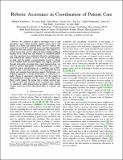| dc.contributor.author | Gombolay, Matthew C. | |
| dc.contributor.author | Hayes, Bradley H | |
| dc.contributor.author | Seo, Nicole | |
| dc.contributor.author | Liu, Zixi | |
| dc.contributor.author | Wadhwania, Samir | |
| dc.contributor.author | Yu, Tania W. | |
| dc.contributor.author | Shah, Neel | |
| dc.contributor.author | Golen, Toni | |
| dc.contributor.author | Shah, Julie A | |
| dc.date.accessioned | 2020-05-20T16:05:51Z | |
| dc.date.available | 2020-05-20T16:05:51Z | |
| dc.date.issued | 2018-06 | |
| dc.identifier.issn | 0278-3649 | |
| dc.identifier.issn | 1741-3176 | |
| dc.identifier.uri | https://hdl.handle.net/1721.1/125347 | |
| dc.description.abstract | We conducted a study to investigate trust in and dependence upon robotic decision support among nurses and doctors on a labor and delivery floor. There is evidence that suggestions provided by embodied agents engender inappropriate degrees of trust and reliance among humans. This concern represents a critical barrier that must be addressed before fielding intelligent hospital service robots that take initiative to coordinate patient care. We conducted our experiment with nurses and physicians, and evaluated the subjects’ levels of trust in and dependence upon high- and low-quality recommendations issued by robotic versus computer-based decision support. The decision support, generated through action-driven learning from expert demonstration, produced high-quality recommendations that were accepted by nurses and physicians at a compliance rate of 90%. Rates of Type I and Type II errors were comparable between robotic and computer-based decision support. Furthermore, embodiment appeared to benefit performance, as indicated by a higher degree of appropriate dependence after the quality of recommendations changed over the course of the experiment. These results support the notion that a robotic assistant may be able to safely and effectively assist with patient care. Finally, we conducted a pilot demonstration in which a robot-assisted resource nurses on a labor and delivery floor at a tertiary care center. | en_US |
| dc.description.sponsorship | National Science Foundation Graduate Research Fellowship Program (Grant 23883577) | en_US |
| dc.language.iso | en | |
| dc.publisher | SAGE Publications | en_US |
| dc.relation.isversionof | http://dx.doi.org/10.1177/0278364918778344 | en_US |
| dc.rights | Creative Commons Attribution-Noncommercial-Share Alike | en_US |
| dc.rights.uri | http://creativecommons.org/licenses/by-nc-sa/4.0/ | en_US |
| dc.source | MIT web domain | en_US |
| dc.title | Robotic assistance in the coordination of patient care | en_US |
| dc.type | Article | en_US |
| dc.identifier.citation | Gombolay, Matthew et al. "Robotic assistance in the coordination of patient care." International Journal of Robotics Research 37, 10 (September 2018): 1300-1316 © 2018 The Author(s). | en_US |
| dc.contributor.department | Lincoln Laboratory | en_US |
| dc.contributor.department | Massachusetts Institute of Technology. Computer Science and Artificial Intelligence Laboratory | en_US |
| dc.contributor.department | Massachusetts Institute of Technology. Department of Aeronautics and Astronautics | en_US |
| dc.relation.journal | International Journal of Robotics Research | en_US |
| dc.eprint.version | Author's final manuscript | en_US |
| dc.type.uri | http://purl.org/eprint/type/JournalArticle | en_US |
| eprint.status | http://purl.org/eprint/status/PeerReviewed | en_US |
| dc.date.updated | 2019-11-01T12:48:08Z | |
| dspace.date.submission | 2019-11-01T12:48:17Z | |
| mit.journal.volume | 37 | en_US |
| mit.journal.issue | 10 | en_US |
| mit.metadata.status | Complete | |
